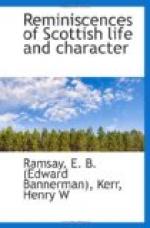I have already referred to a custom which prevailed in all the rural parish churches, and which I remember in my early days at Fettercairn; the custom I mean, now quite obsolete, of the minister, after pronouncing the blessing, turning to the heritors, who always occupied the front seats of the gallery, and making low bows to each family. Another custom I recollect:—When the text had been given out, it was usual for the elder branches of the congregation to hand about their Bibles amongst the younger members, marking the place, and calling their attention to the passage. During service another handing about was frequent among the seniors, and that was a circulation of the sneeshin-mull or snuff-box. Indeed, I have heard of the same practice in an Episcopal church, and particularly in one case of an ordination, where the bishop took his pinch of snuff, and handed the mull to go round amongst the clergy assembled for the solemn occasion within the altar-rails.
Amongst Scottish reminiscences which do not extend beyond our own recollections we may mention the disappearance of Trinity Church in Edinburgh, which has taken place within the last quarter of a century. It was founded by Mary of Gueldres, queen of James II. of Scotland, in 1446, and liberally endowed for a provost, prebendaries, choristers, etc. It was never completed, but the portions built—viz., choir, transept, and central tower—were amongst the finest specimens of later Gothic work in Scotland. The pious founder had placed it at the east end of what was then the North Loch. She chose her own church for the resting-place of her remains as a sanctuary of safety and repose. A railway parliamentary bill, however, overrides founder’s intentions and Episcopal consecrations. Where once stood the beautiful church of the Holy Trinity, where once the “pealing organ” and the “full-voiced choir” were daily heard “in service high and anthems clear”—where for 400 years slept the ashes of a Scottish Queen—now resound the noise and turmoil of a railway station.
But we have another example of the uncertainty of all earthly concerns, and one which supplies a Scottish reminiscence belonging to the last seventy years. Wilhelmina, Viscountess Glenorchy, during her lifetime, built and endowed a church for two ministers, who were provided with very handsome incomes. She died 17th July 1786, and was buried on the 24th July, aged 44. Her interment took place, by her own direction,




